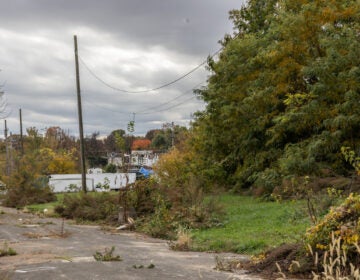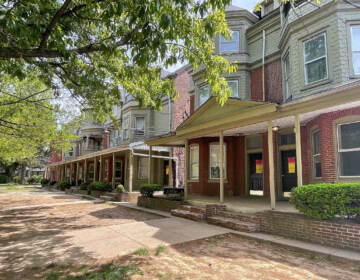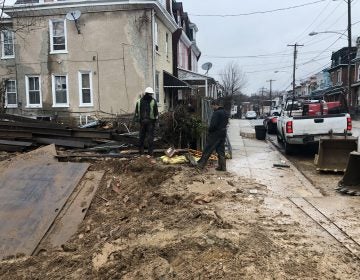Hard questions, tough calls

When planners, developers, government officials, architects and real estate brokers get together to knock heads about big-picture problems, it’s often the private-side people who end up mixing things up.
Are we ever going to communicate the urgency of our enormous infrastructure dilemma in practical terms, somehow, to the public? Why not incentivize Center City District street sweepers and other city employees to learn another language, then give them a badge and throw a few more bucks their way each month? Have we ever thought about selling the airport?
Ken Balin, Gerry Cope and John Gattuso, respectively, wanted to know.
The three (Balin is CEO of AMC Delancey Group, a Center City private real estate investor; Gattuso is a senior vice president and regional director for Liberty Property Trust; and Gerry Cope is Gerry Cope) were among a crowd gathered at the Union League for Tuesday afternoon’s monthly membership meeting of the Central Philadelphia Development Corp. CPDC is the sister group to the Center City District.
As the nation’s increasingly dire economic straits steadily reveal themselves, CPDC members took stock of the effects of Mayor Michael Nutter’s freeze on tax reductions and other issues, such as plans for “strengthened competitive transportation assets” and infrastructure upgrades. Examples, such as service enhancements at SEPTA and an expansion of the Philadelphia International Airport – long-term goals with intended short-term start dates – were being counted on to spur growth, but are now in limbo.
CPDC and CCD Executive Director Paul Levy gave a brief presentation of the tax reduction plan stalled by the city’s massive budget shortfall, and introduced Gattuso and two other speakers: Thomas Morr, president and CEO of Select Greater Philadelphia, and Joseph Casey, general manager for SEPTA.
While the city’s tax reductions, meant to level the playing field with other cities to better compete for businesses and employees, will come to a halt after Jan. 1, Levy said the news was not all bad. The effects of that freeze will be somewhat mitigated by gaming revenues from the Commonwealth, which started to flow in the summer. “Which means, quite simply, that whether you like it or not, the sooner casinos open in Philadelphia, the more gross gaming revenue there is, the faster the wage tax comes down,” Levy said.
Air, tight
Both Morr and Gattuso spoke in detail about Philadelphia International Airport. Its growth prospects, which are critical to a corresponding growth in the region’s economy, are constrained, largely by physical boundaries. “It’s bounded by I-95 on the north, the Delaware River on the south, Tinicum Township [and its residential neighborhood to the southeast],” Morr said. “On the other end … we see a waste water treatment facility, a [Sunoco] docking facility on the Delaware River, and a facility for the Army Corps of Engineers. All of those things constrain the ability of this airport to meet the needs of the community as we go forward.”
In addition, Philadelphia sits in the heart of the northeast aircraft corridor, Morr said, meaning Philly International is further constrained by competing East Coast flyover traffic between Washington and New York.
Yet for all that, PIA is the 10th busiest airport in the nation, the recipient of about $1 billion in improvements over the past decade, Morr said, with consistently high customer satisfaction rates. But one of the most important economic development tools planned for the region is one that gets scant attention – a new, independent, parallel runway that would be built along the length of the Delaware, allowing for simultaneous arrivals.
Without that elevated critical mass, Morr said we would not have the capacity needed for the demand being forecast. We also need additional gates and dual taxiing capacity for aircraft. Inside the terminal, additional corridor space is needed, with improvement to back-room operations and a sort of “transportation center” that will speed the public’s arrival at, and departure from, the airport.
Room to move
While those constraints are real, the other side of the coin is that Philadelphia is one of the few eastern seaboard regions where great mobility stretches out in every direction, Gattuso said. At Liberty, he said one employee lives as far west as Elverson, Pa., while another commutes daily from Atlantic City.
Living between the financial and political capitals of the nation, something often thought of as a negative, is also one of the enormous advantages of the Delaware Valley, Gattuso said. “It is a major strategic benefit and competitive advantage for this region.”
As for the airport, “the competitiveness and the wear-and-tear are extreme,” Gattuso said. “While there is much to be applauded” about the past decade’s operations, the $1 billion spent has been little more than “a series of Band-Aids. That facility, to remain competitive, needs a significant re-thinking.”
Gattuso said it was worth wondering who will control the airport’s challenging expansion plans. “Maybe one of the answers lies in creating an agency” that combines several operations, including parking, he said.
“Perhaps even sell the airport,” he offered. Revenues could go toward eliminating the business privilege tax, for example.
“The idea of thinking big is critical in a world where we’re going to have to be competitive not just with New York and Washington,” but also Chicago, the Bay Area, London and other cities where companies consider new headquarters locations, Gattuso said. “We are absolutely in worldwide competition.”
Getting it together
To that end, Gattuso – who seems to have a knack for the polite articulation of blunt-force thoughts – said he recently was coming home from a business trip to Munich when he “was struck by the provinciality” on display at Philly International. Nothing but the English language can be seen on signs, and from an example he gave, it was obvious to foreign visitors that multilingual employees were scarce. “The difference is stunning,” he observed. Later he said, “There really is no excuse. We should be embarrassed.”
In this, Gattuso hit on a sort of theme of the afternoon – that Philadelphia’s gateways, via air, rail or car, have much to be desired.
Gerry Cope, senior partner and founder of Cope Linder Architects, took the microphone during the Q&A session and spoke of the “pride of place” of his adopted city. In a tone only a Brit could muster, he said he was embarrassed to take friends and relatives to New York. “Going through Philadelphia on Amtrak is appalling!” he said, referring to the corridors of North Philadelphia that Morr said “look like Dresden after the war.” Cope proposed a program for teens to clean it up and get rid of the graffiti and broken windows, for starters.
Cope also agreed with Gattuso’s observations on language, and had a partial solution: offer Center City District workers an incentive to learn French, or German, or Arabic, and boost their pay accordingly, with badges for their uniforms so tourists can identify them.
With the economy the way it is, it’s very noticeable that the public is aware that things need to be changed, Balin said. You can see it in the big jump in SEPTA ridership during the past year.
“It seems to me that our elected politicians” need to explain to the public what our alternatives are, Balin said, through a sort of ‘simulated city’ vision of what Philadelphia “will be like in 25 years of doing nothing – what do the roads look like, what do the bridges look like, what does the city look like? That if we don’t do something, what are the personal consequences of that?”
We can add an extra car or two to regional rail lines in the short-term, he continued, but, “What are we doing to lay out the case” for the hard choices that will need to be made individually and collectively?
Others posed similar questions: Who is going to lead the main discussion to put this all together? What about a regional council of governments, something that has been discussed as a means to consolidate that kind of hands-on leadership?
“What needs to happen is not so much consolidation as a need to have a series of strategic alliances between organizations, to try to come up with a set of regional and city priorities,” Levy told PlanPhilly after the meeting. “Because what happens is they cancel each other out. It’s A wants something and B wants something, there’s no one message in Harrisburg or in Washington. So I think several of the questions here were reaching toward, ‘Can we agree upon a set of strategic priorities at the airport, or at SEPTA, [or] with any gateways to the city.”
He pointed to a recent meeting of the local chapter of the Urban Land Institute and a subgroup of CEOs within Select Greater Philadelphia that recently met to initiate long-term priorities for the airport. “It’s really time to do that,” Levy said. “And I particularly think now that we’re in an economic downturn, when there’s so much news that is negative, that the role of government and civic groups is really laying out the improvement agenda – the vision of where we’re going, and doing the small things that sustain and build confidence.”
Antonio Fiol-Silva, an architect, urban designer and principal with Wallace Roberts & Todd LLC, agreed with others that discussions like Tuesday’s need immediate follow-up, especially since a major infrastructure movement could erupt as the economy shifts and the federal government pivots to a new administration.
“You have to have a really compelling case, so that when somebody who is looking to invest is ready, you’re ready too,” Fiol-Silva said. “If you re-invest in the rail stations, and the rail corridor, and look at the land use that is needed, it becomes a promotion piece, and we go out there and we sell the promotion. Just like in Portland, where they are ‘the streetcar city.’ And who else has our proximity and connectivity? … You have to start dreaming big.”
Staring at a bleak 2009, the big picture is really the only picture, it seems. The economy’s effects on development are being felt all over the country, say officials from the Urban Land Institute, speaking at a gathering of commercial real estate professionals at the Hyatt Bellevue on Nov. 25.
“Forget the quick fix,” said Stephen Blank, a ULI researcher and adviser, quoting the title of the opening chapter of the group’s annual “Emerging Trends in Real Estate” outlook booklet, which includes detailed market information on multiple U.S. regions and the results of questionnaires distributed nationwide.
“For 2009, U.S. commercial real estate faces its worst year since the wrenching 1991-1992 industry depression,” he said. “Values will drop substantially, foreclosures and delinquency rates will increase sharply, and a limping economy likely will crimp property cash flows.”
The upside locally is that Philadelphia has “several industries that are propelling growth and job creation – the life sciences, IT/technology, health care, hospitality and sustainability,” said Greg Byrnes, editor and publisher of Greater Philadelphia, a regional business magazine focused on projects and trends, and the former head of economic development at PECO. “In addition, our commercial real estate sector, while taking a few hits to its midsection, has proven resilient. There are several major projects under construction and many others in the planning stages.”
Later this week in PlanPhilly: SEPTA’s growing pains; and the latest on Market East.
Contact the reporter at thomaswalsh1@gmail.com
WHYY is your source for fact-based, in-depth journalism and information. As a nonprofit organization, we rely on financial support from readers like you. Please give today.






